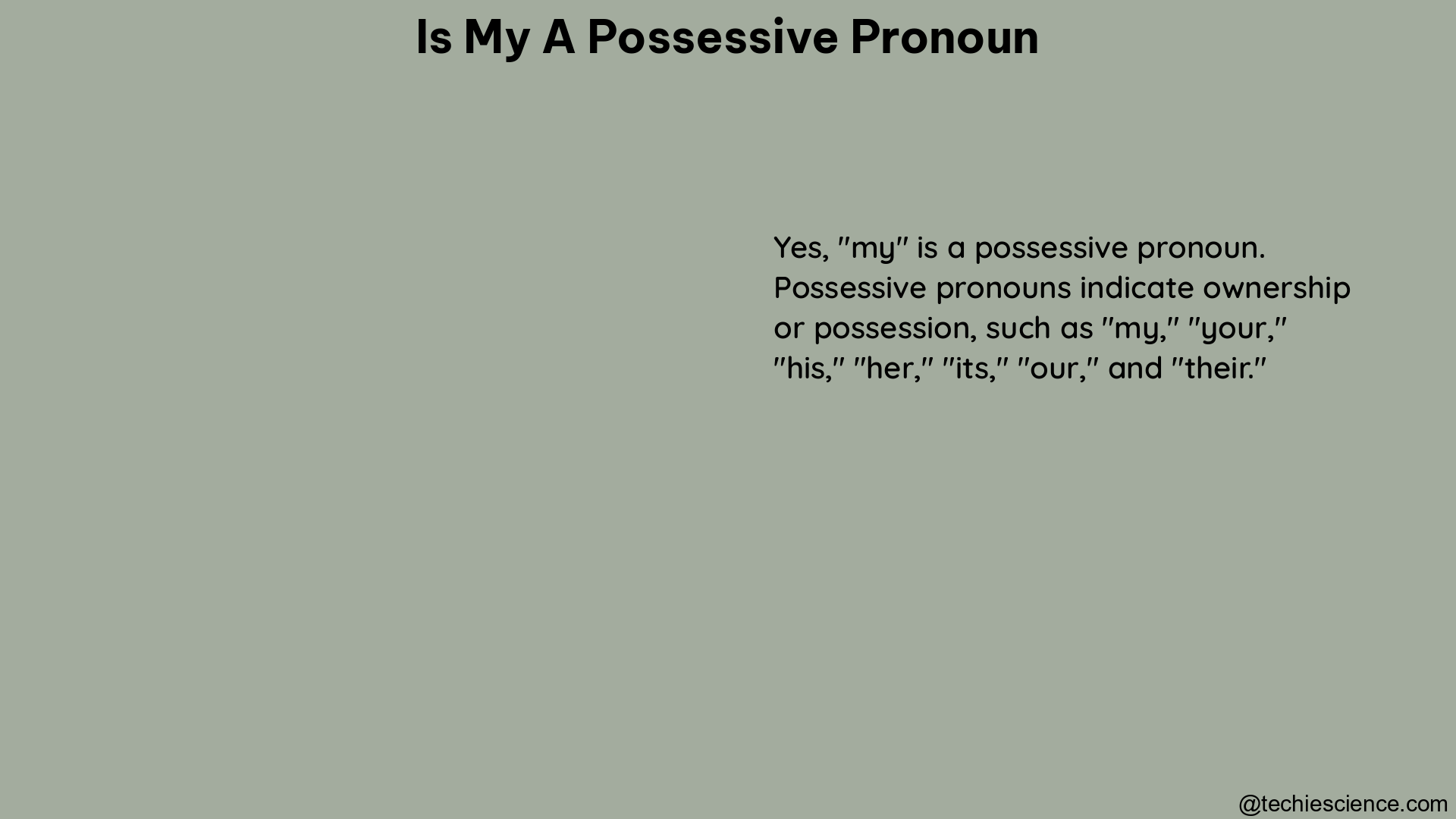No, “my” is not a possessive pronoun. It is classified as a possessive determiner (or possessive adjective) because it is used to modify a noun and indicate possession, but it does not stand alone as a pronoun. Possessive determiners appear before a noun, whereas possessive pronouns replace a noun phrase.
Understanding Possessive Determiners and Possessive Pronouns
Possessive Determiners
Possessive determiners are words that modify a noun to indicate ownership or possession. They come before the noun they modify. Some examples of possessive determiners include:
- My
- Your
- His
- Her
- Its
- Our
- Their
Here are some examples of possessive determiners in use:
- My car is red.
- That is your book.
- The student finished his homework.
- She wore her favorite dress.
- The company lost its way in the market.
- We cleaned our house yesterday.
- The team celebrated their victory.
In each of these examples, the possessive determiner modifies the noun that follows it, indicating who the object belongs to.
Possessive Pronouns
Possessive pronouns, on the other hand, replace a noun phrase and stand on their own to indicate ownership or possession. Some examples of possessive pronouns include:
- Mine
- Yours
- His
- Hers
- Its
- Ours
- Theirs
Here are some examples of possessive pronouns in use:
- This car is mine.
- That book is yours.
- The victory was his.
- The dress is hers.
- The company lost its way in the market.
- The house is ours.
- The trophy belongs to them, so it is theirs.
In these examples, the possessive pronouns replace the noun phrases that would have been used in the sentence, such as “my car,” “your book,” “his victory,” and so on.
The Difference Between Possessive Determiners and Possessive Pronouns

The main difference between possessive determiners and possessive pronouns is that possessive determiners modify a noun, while possessive pronouns replace a noun phrase.
Here’s a table that summarizes the key differences:
| Possessive Determiners | Possessive Pronouns |
|---|---|
| Modify a noun | Replace a noun phrase |
| Appear before the noun | Stand alone |
| Examples: my, your, his, her, its, our, their | Examples: mine, yours, his, hers, its, ours, theirs |
| “This is my car.” | “This car is mine.” |
It’s important to note that while “my” is a possessive determiner, “mine” is a possessive pronoun. The same applies to the other possessive forms: “your” vs. “yours,” “his” vs. “his,” and so on.
Identifying Possessive Determiners and Possessive Pronouns
To identify whether a word is a possessive determiner or a possessive pronoun, you can apply the following tests:
- Modifies a Noun: If the word appears before a noun and modifies it, it is a possessive determiner.
- Example: “This is my car.”
- Stands Alone: If the word replaces a noun phrase and stands on its own, it is a possessive pronoun.
- Example: “This car is mine.”
Here are some additional examples to help you distinguish between possessive determiners and possessive pronouns:
- Possessive Determiner: “That is her book.”
- Possessive Pronoun: “The book is hers.”
- Possessive Determiner: “I bought their new laptop.”
- Possessive Pronoun: “The laptop is theirs.”
- Possessive Determiner: “We cleaned our house yesterday.”
- Possessive Pronoun: “The house is ours.”
By understanding the differences between possessive determiners and possessive pronouns, you can accurately identify and use them in your writing and speech.
Common Mistakes and Misunderstandings
One common mistake is confusing possessive determiners and possessive pronouns. For example, some people might say “This is mine car” instead of “This is my car.” This is incorrect because “mine” is a possessive pronoun, not a possessive determiner.
Another common mistake is using possessive pronouns in situations where possessive determiners are required. For example, some people might say “This is mine car” instead of “This is my car.” This is also incorrect because “my” is the appropriate possessive determiner in this context.
It’s important to be aware of these common mistakes and to practice using possessive determiners and possessive pronouns correctly in your writing and speech.
Conclusion
In summary, “my” is a possessive determiner, not a possessive pronoun. Possessive determiners modify nouns to indicate ownership or possession, while possessive pronouns replace noun phrases and stand on their own. Understanding the difference between these two grammatical concepts is crucial for effective communication and writing.
By mastering the use of possessive determiners and possessive pronouns, you can improve your overall language skills and ensure that your writing and speech are clear, precise, and grammatically correct.
Reference:
- Possessive Determiners vs. Possessive Pronouns
- Possessive Determiners and Possessive Pronouns
- Possessive Determiners vs. Possessive Pronouns: What’s the Difference?

Hi, I am Srishti Mukherjee. I have completed my M.A. in English.
I always like to explore new zones in the field of English Literature
Apart from this, I like to read Novels and watch movies.